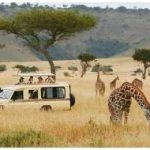Kenya is an East African country. Located to the south of the so-called Horn of Africa, it is bathed by the Indian Ocean in the southeast, and borders Ethiopia in the north, Somalia in the east, Tanzania, in the south, Uganda in the west, and Sudan, northwest. It covers an area of 582 650 km2. The main cities are Nairobi, the capital, with 2 504 400 residents (2004), Mombasa (777 100 residents), Nakuru (256 300 residents), Kisumu (227 100 residents) And Machakos (33 800 residents).
In the western half of Kenya there are several high-altitude lakes, the formation of which is related to the region’s tectonic activity.
From the point of view of the relief, the southwest region stands out, with high plateaus, in which there are several mountains of volcanic origin, such as Mount Kenya (with an altitude of 5199 meters). This plateau extends to other neighboring countries, such as Tanzania, whose best known volcanic summit is Mount Quilimanjaro (the highest point in Africa, at 5895 meters), located on the border with Kenya.
Climate
The dominant climate is tropical. On the coast, it has characteristics of humid tropical, while in the North it is distinctly dry tropical. The higher regions have a tropical altitude climate, where temperatures are much more moderate.
Economy
Kenya is not a mineral-rich country. The basis of the economy is agriculture, although only 4% of the land is arable. Tea is the main export product, with the cultivated area having increased considerably between 1991 and 1995. Although with a much lower production than tea, coffee appears immediately afterwards. However, tourism is the main source of foreign exchange in the country. Several natural parks were created, whose revenues have been increasing and being shared with the local population, which, in this way, collaborates in the maintenance of this resource. Poaching is one of the problems to be solved within natural parks whose main tourist attraction consists of safaris to observe and photograph lions, leopards, elephants, buffalo, gazelles, crocodiles, wild dogs and many other species. The country’s largest manufacturing unit is the oil refinery in Mombasa, the most important port in East Africa. Kenya’s main trading partners are the United Kingdom, Germany, the United Arab Emirates and Japan.
Environmental indicator: the value of carbon dioxide emissions, per capita (metric tons, 1999), is 0.3.
Population
The population is 34 707 817 residents (2006), which corresponds to a population density of 58.06 residents/km2. The birth and death rates are respectively 39.72% and 14.02%. Average life expectancy is 48.93 years. The value of the Human Development Index (HDI) is 0.489 and the value of the Gender-adjusted Development Index (IDG) is 0.488 (2001).
There are more than 30 ethnic groups that are distinguished by language and culture. Tribal tensions have always threatened to provoke deep divisions within the country. The most numerous groups are the Kikuyu (18%), the Luhya (12%), the Luo (11%), the Kalenjin (10%) and the Kamba (10%). The most representative religions are Catholicism (27%), Protestantism (19%) and traditional beliefs (19%). Dialects belonging to various language groups are spoken, but Swahili and English are the official languages.
History
This African country is entirely a colonial creation, first under the control of the British East African Company and then, from 1895, in the form of a British protectorate. In 1920, the territory became an English colony and, in 1963, it became independent following the action of a nationalist movement that led the first African armed struggle for independence. For Kenya democracy and rights, please check getzipcodes.
- Countryaah.com: Offers a full list of airports in the country of Kenya, sorted by city location and acronyms.
- Abbreviationfinder.org: Provides most commonly used abbreviations and initials containing the country name of Kenya. Listed by popularity.
1UpTravel.com – Maps of Kenya
Browse a collection of city, shaded relief and political maps of this Eastern African country, bordering the Indian Ocean. Includes the city maps of Nairobi and Mombasa.
Website: http://www.1uptravel.com/worldmaps/kenya.html
Kenya – Graphic Maps
Find out where Lake Rudolph is by viewing the map of this African nation. Includes facts and figures about the population and economy.
Website: http://www.graphicmaps.com/aatlas/africa/maps/kenya.htm
Kenya – InfoPlease.com Map
Easily locate populated areas, country borders and river systems with this color graphic map of Kenya.
Website: http://ln.infoplease.com/atlas/country/kenya.html
Kenya – National Geographic Map Machine
Look at a topographical map of the nation known for its wildlife. Its capital, Nairobi, is East Africa’s commercial hub.
Website: http://plasma.nationalgeographic.com/mapmachine/index.html?i
Kenya – University of Texas Library
Check out a political map and find out where the capital is. Also features city maps of Nairobi and Mombasa.
Website: http://www.lib.utexas.edu/Libs/PCL/Map_collection/kenya.html




